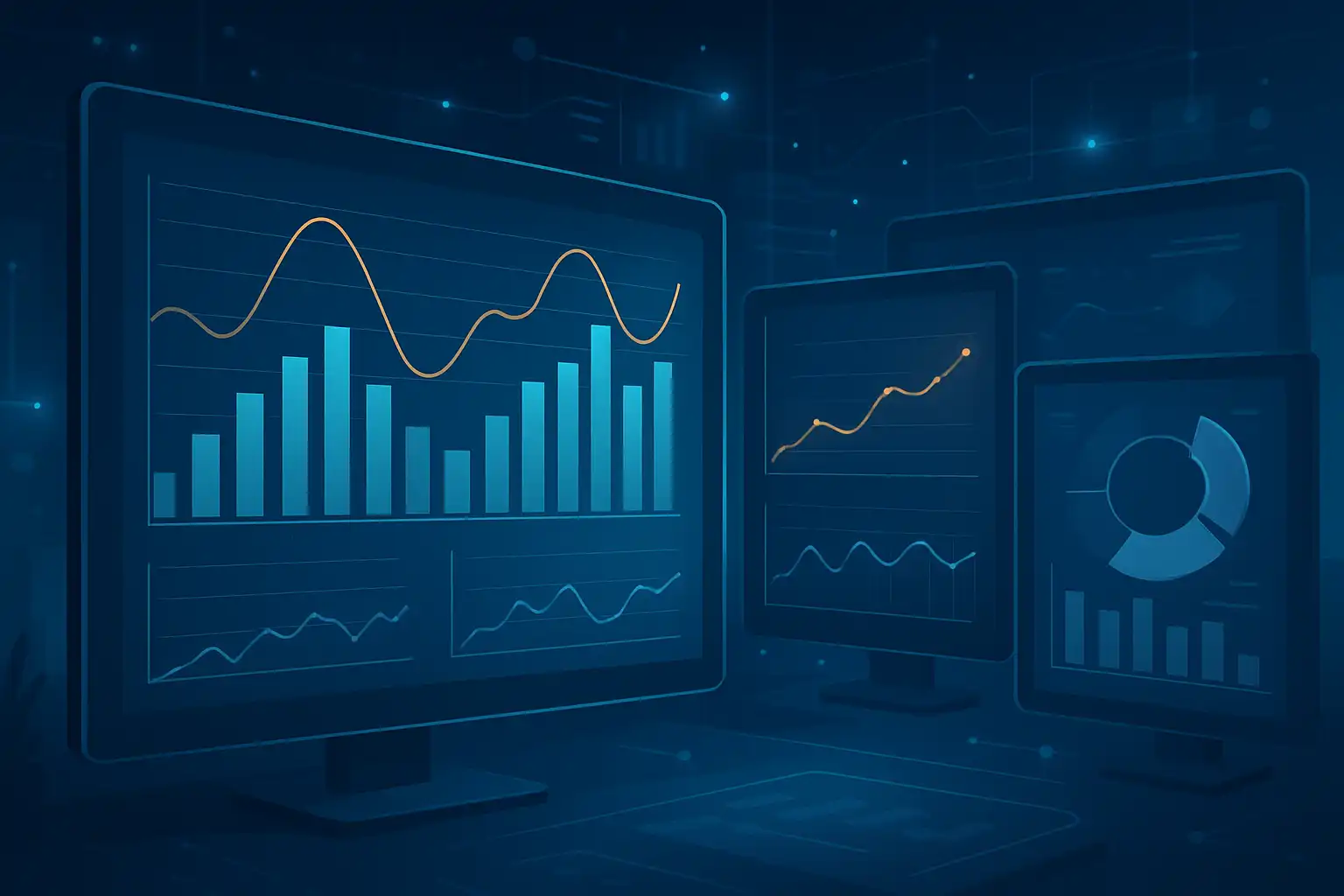
If you’ve wondered when to use time series forecasting, you’re not alone. Organizations of all sizes are turning to this technique for smarter, more reliable planning. Time series forecasting uses historical data—such as sales, demand, or prices recorded over time—to predict future values. If your business relies on regular reporting, needs to anticipate seasonal changes, or wants to stay ahead of uncertainty, understanding when to use time series forecasting can make your planning more effective and data-driven.
What is Time Series Forecasting and Why Is It Useful?
Time series forecasting is a method used to predict future values based on past trends and patterns. You often see it in action when a retailer predicts next month’s sales, a power company estimates electricity use, or a logistics manager plans for inventory needs. By learning from previous data, this approach gives decision-makers a clearer picture of what’s likely to happen next.
Why does this matter? Businesses, governments, and even non-profits often face the same core challenges: uncertainty, limited resources, and changing environments. Forecasting allows organizations to prepare, adjust, and optimize with greater confidence. If your team’s decisions hinge on what may happen next week, month, or quarter, forecasting can provide a much-needed edge.

How Do You Know When to Use Time Series Forecasting?
Several key indicators help you decide if time series forecasting is right for your planning process. Let’s look at the most common situations:
- Availability of Historical Data: You have regular, time-stamped records for the item or metric you want to predict. For example, years of monthly revenue or weekly website visits.
- Clear Patterns or Trends: There’s evidence of seasonality, growth, decline, or repeating cycles. For example, sales always rise during holidays or dip in the summer.
- Ongoing Forecast Needs: Your organization requires repeated forecasting for reporting, budgeting, or operational updates. For instance, planning monthly demand or daily staffing.
- Influence from Known Events: Results are affected by planned events or market shifts, such as promotions, holidays, weather, or economic changes.
- Enough Data for Modeling: You have a suitably large set of past data, which helps create more reliable forecasts.
- Accuracy and Repeatability Matter: Small errors can mean lost opportunities or wasted resources, so getting forecasts right is critical.
For example, a retailer planning seasonal promotions benefits greatly from forecasting because they can see when demand will rise or fall, order inventory accordingly, and reduce the risk of overstocking or running out. In such planning, using a time series forecasting guide & examples can provide practical insights and support model selection.
Common Scenarios That Call for Time Series Forecasting
- Projecting sales, marketing performance, or product demand
- Anticipating energy consumption or resource use
- Predicting customer support requests or website traffic
- Monitoring and forecasting cash flow, payments, or revenue
- Scheduling staff or supply chain logistics
What Types of Businesses and Data Patterns Benefit Most?
Time series forecasting is especially valuable for organizations that see repeating events, clear cycles, or seasonal effects in their data. If your sales spike every Black Friday or you spend more on ads in certain months, forecasting these swings helps you make informed choices ahead of time.
Businesses with long-term, high-volume historical records are ideal candidates—think supermarkets, airlines, e-commerce firms, manufacturers, or energy providers. Even smaller businesses, if they collect regular data (like daily orders), can benefit from forecasting, particularly when growth or cost control matters.
Patterns that benefit most include:
- Trends (upward or downward, such as steady growth in subscribers)
- Seasonality (regular spikes or dips tied to time of year or events)
- Cycles (complex, multi-year patterns or economic cycles)
- Recurring promotions or campaign-driven activity
- Multiple related measures—such as sales across product lines or locations
For teams seeking to align operational planning to business goals, integrating forecasting with data strategy alignment with business goals provides a foundation for more cohesive decision-making.
How Does Time Series Forecasting Improve Planning?
Making decisions with a clear sense of future trends allows organizations to:
- Allocate Resources Effectively: Avoid understaffing, overstocking, or missing sales opportunities by predicting demand accurately.
- Budget with Confidence: Financial teams use forecasts to plan expenses, manage cash flow, and set realistic targets.
- Adapt to Market Changes: When forecasts reflect trends or sudden events, you can pivot strategies before challenges hit.
- Reduce Risk: Accurate predictions minimize losses from stockouts, over-ordering, or missed opportunities.
- Learn and Improve: Comparing forecasted results to actual outcomes highlights areas for improvement, helping refine future predictions.
Machine Learning and Automation: Enhancing Accuracy
Modern forecasting tools use machine learning to spot subtle patterns and adapt as new data arrives. Solutions from brands like AWS, Google Cloud, and open-source libraries such as Prophet and ARIMA models make forecasting more accessible for non-experts. These tools can process vast datasets, handle complex influences—like major holidays or ad campaigns—and even flag unusual spikes or drops (anomaly detection).
By automating time series forecasting, companies can generate automated reporting for accurate and timely insights that support rapid decision-making and continuous improvement.

What Should You Consider Before Relying on Time Series Forecasting?
Not every situation is suitable for forecasting. Before applying these methods, consider:
- Data Quality: Incomplete, unreliable, or noisy data can lead to poor forecasts.
- Length of History: More historical data usually means better accuracy, especially for capturing rare events.
- External Factors: Some events—like sudden policy changes or global crises—are difficult to predict, even with the best data.
- Complexity vs. Simplicity: Overly complex models might not perform better and can be harder to explain to stakeholders.
- Actionability: Use forecasts where they truly impact decisions, not just as reporting metrics.
Examples of Effective Time Series Forecasting
- A retailer adjusts stock for winter holidays using demand forecasts, reducing excess inventory and lost sales.
- A city government predicts energy usage to avoid power shortages during heatwaves.
- An online marketplace plans marketing spend by anticipating peak traffic days based on past campaigns.
- Manufacturers predict machine maintenance needs, avoiding production delays.
Steps to Start Using Time Series Forecasting
- Identify the metric or event you want to predict (e.g., daily sales)
- Gather and clean your historical time-stamped data
- Analyze for trends, seasonality, or cycles
- Select a forecasting model (simple averages, moving averages, ARIMA, or machine learning-based models)
- Train the model on your data and validate predictions
- Deploy the forecast into your planning process—update regularly as new data arrives
For practical guidance and hands-on examples, you may want to consult resources like a time series forecasting guide & examples as you develop your organization’s approach.
FAQ: Common Questions About Time Series Forecasting in Planning
- What is the minimum data needed for time series forecasting?
Usually, you need at least several periods (months or years) of consistent, time-stamped data to build a useful forecast. The more data, especially with seasonal or erratic patterns, the better your model can learn. - Does time series forecasting only work for large businesses?
No, it works for any size organization—as long as you have regular historical data. Even small retailers, clinics, or local services can use forecasting to improve scheduling, orders, or budgets. - Can machine learning improve time series forecasting?
Yes, machine learning-based forecasting can spot deeper patterns, handle multiple influencing factors, and adapt as data changes. This often leads to more accurate and scalable forecasts, especially for complex or high-volume businesses. - What are the limitations of time series forecasting?
Forecasting may not predict sudden, one-off events like natural disasters or unexpected policy changes. The quality of your data and the right choice of model also play major roles in accuracy.
